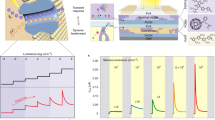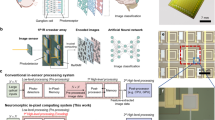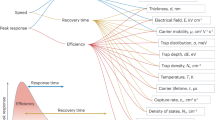Abstract
Machine vision systems that capture images for visual inspection and identification tasks have to be able to perceive a scene under a range of illumination conditions. To achieve this, current systems use circuitry and algorithms that compromise efficiency and increase complexity. Here we report bioinspired vision sensors that are based on molybdenum disulfide phototransistors and exhibit time-varying activation and inhibition characteristics. Charge trap states are intentionally introduced into the surface of molybdenum disulfide, enabling the dynamic modulation of the photosensitivity of the devices under different lighting conditions. The light-intensity-dependent characteristics of the sensors match Weber’s law in which the perceived change in stimuli is proportional to the light stimuli. The approach offers visual adaptation with highly localized and dynamic modulation of photosensitivity under different lighting conditions at the pixel level, creating an effective perception range of up to 199 dB. The phototransistor arrays exhibit image contrast enhancement for both scotopic and photopic adaptation.
This is a preview of subscription content, access via your institution
Access options
Access Nature and 54 other Nature Portfolio journals
Get Nature+, our best-value online-access subscription
$29.99 / 30 days
cancel any time
Subscribe to this journal
Receive 12 digital issues and online access to articles
$119.00 per year
only $9.92 per issue
Buy this article
- Purchase on Springer Link
- Instant access to full article PDF
Prices may be subject to local taxes which are calculated during checkout




Similar content being viewed by others
Data availability
Source data are provided with this paper. The data that support the plots within these paper and other findings of this study are available from the corresponding authors upon reasonable request.
Code availability
The codes used for simulation and data plotting are available from the corresponding authors upon reasonable request.
References
Gu, L. et al. A biomimetic eye with a hemispherical perovskite nanowire array retina. Nature 581, 278–282 (2020).
Mennel, L. et al. Ultrafast machine vision with 2D material neural network image sensors. Nature 579, 62–66 (2020).
Chai, Y. In-sensor computing for machine vision. Nature 579, 32–33 (2020).
Zhou, F. & Chai, Y. Near-sensor and in-sensor computing. Nat. Electron. 3, 664–671 (2020).
Liao, F., Zhou, F. & Chai, Y. Neuromorphic vision sensors: principle, progress and perspectives. J. Semicond. 41, 013105 (2020).
Darmont, A. High dynamic range imaging: sensors and architectures. In Society of Photo-Optical Instrumentation Engineers (SPIE, 2013).
Wang, C.-Y. et al. Gate-tunable van der Waals heterostructure for reconfigurable neural network vision sensor. Sci. Adv. 6, eaba6173 (2020).
Sun, L. et al. In-sensor reservoir computing for language learning via two-dimensional memristors. Sci. Adv. 7, eabg1455 (2021).
Ohta, J. Smart CMOS Image Sensors and Applications (CRC Press, 2017).
Liba, O. et al. Handheld mobile photography in very low light. ACM Trans. Graph. 38, 164 (2019).
Rao, Z. et al. Curvy, shape-adaptive imagers based on printed optoelectronic pixels with a kirigami design. Nat. Electron. 4, 513–521 (2021).
Kim, M. S. et al. An aquatic-vision-inspired camera based on a monocentric lens and a silicon nanorod photodiode array. Nat. Electron. 3, 546–553 (2020).
Xie, D. Xie et al. Photoelectric visual adaptation based on 0D‐CsPbBr3‐quantum‐dots/2D‐MoS2 mixed‐dimensional heterojunction transistor. Adv. Funct. Mater. 31, 2010655 (2021).
Hong, S. et al. Sensory adaptation and neuromorphic phototransistors based on CsPb(Br1–xIx)3 perovskite and MoS2 hybrid structure. ACS Nano 14, 9796–9806 (2020).
Kwon, S. M. et al. Environment-adaptable artificial visual perception behaviors using a light-adjustable optoelectronic neuromorphic device array. Adv. Mater. 31, 1906433 (2019).
He, Z. et al. An organic transistor with light intensity-dependent active photoadaptation. Nat. Electron. 4, 522–529 (2021).
Wang, Q. H., Kalantar-Zadeh, K., Kis, A., Coleman, J. N. & Strano, M. S. Electronics and optoelectronics of two-dimensional transition metal dichalcogenides. Nat. Nanotechnol. 7, 699–712 (2012).
Fiori, G. et al. Electronics based on two-dimensional materials. Nat. Nanotechnol. 9, 768–779 (2014).
Liu, Y. et al. Promises and prospects of two-dimensional transistors. Nature 591, 43–53 (2021).
Jang, H. et al. An atomically thin optoelectronic machine vision processor. Adv. Mater. 32, e2002431 (2020).
Choi, C. et al. Human eye-inspired soft optoelectronic device using high-density MoS2-graphene curved image sensor array. Nat. Commun. 8, 1664 (2017).
Choi, C. et al. Curved neuromorphic image sensor array using a MoS2-organic heterostructure inspired by the human visual recognition system. Nat. Commun. 11, 5934 (2020).
Lopez-Sanchez, O., Lembke, D., Kayci, M., Radenovic, A. & Kis, A. Ultrasensitive photodetectors based on monolayer MoS2. Nat. Nanotechnol. 8, 497–501 (2013).
Nur, R. et al. High responsivity in MoS2 phototransistors based on charge trapping HfO2 dielectrics. Commun. Mater. 1, 103 (2020).
Lee, J. et al. Monolayer optical memory cells based on artificial trap-mediated charge storage and release. Nat. Commun. 8, 14734 (2017).
Miller, R. E. & Tredici, T. J. Night Vision Manual for the Flight Surgeon. (ARMSTRONG LAB BROOKS AFB TX, 1992).
Seetzen, H. et al. High dynamic range display systems. In ACM SIGGRAPH 2004 Papers 760–768 (Association for Computing Machinery, 2004).
Kalloniatis, M. & Luu, C. Light and dark adaptation. In Webvision: The Organization of the Retina and Visual System (eds Kolb, H. et al.) (Univ. Utah Health Sciences Center, 1995).
Fechner, G. Elements of Psychophysics Vol. I (Holt, Rinehart and Winston, 1966).
Kandel, E. R. et al. Principles of Neural Science Vol. 4 (McGraw-Hill, 2000).
Meister, M. & Tessier-Lavigne, M. Low-level visual processing: the retina. Prin. Neural Sci. 5, 577–601 (2013).
Jiang, J. et al. Rational design of Al2O3/2D perovskite heterostructure dielectric for high performance MoS2 phototransistors. Nat. Commun. 11, 4266 (2020).
Park, Y., Baac, H. W., Heo, J. & Yoo, G. Thermally activated trap charges responsible for hysteresis in multilayer MoS2 field-effect transistors. Appl. Phys. Lett. 108, 083102 (2016).
Kaushik, N. et al. Reversible hysteresis inversion in MoS2 field effect transistorsr. npj 2D Mater. Appl. 1, 34 (2017).
Fang, H. & Hu, W. Photogating in low dimensional photodetectors. Adv. Sci. 4, 1700323 (2017).
Wu, J. Y. et al. Broadband MoS2 field-effect phototransistors: ultrasensitive visible-light photoresponse and negative infrared photoresponse. Adv. Mater. 30, 1705880 (2018).
Kufer, D. & Konstantatos, G. Highly sensitive, encapsulated MoS2 photodetector with gate controllable gain and speed. Nano Lett. 15, 7307–7313 (2015).
Pierre, A., Gaikwad, A. & Arias, A. C. Charge-integrating organic heterojunction phototransistors for wide-dynamic-range image sensors. Nat. Photon. 11, 193–199 (2017).
Gong, X. et al. High-detectivity polymer photodetectors with spectral response from 300 nm to 1450 nm. Science 325, 1665–1667 (2009).
Peng, B. et al. Achieving ultrafast hole transfer at the monolayer MoS2 and CH3NH3PbI3 perovskite interface by defect engineering. ACS Nano 10, 6383–6391 (2016).
Chen, M. et al. Multibit data storage states formed in plasma-treated MoS2 transistors. ACS Nano 8, 4023–4032 (2014).
Zhou, F. et al. Optoelectronic resistive random access memory for neuromorphic vision sensors. Nat. Nanotechnol. 14, 776–782 (2019).
Choi, M. et al. Full-color active-matrix organic light-emitting diode display on human skin based on a large-area MoS2 backplane. Sci. Adv. 6, eabb5898 (2020).
Acknowledgements
This work was supported by China Postdoctoral Science Foundation (2021M692221); Research Grant Council of Hong Kong (15205619); Science, Technology and Innovation Commission of Shenzhen (JCYJ20180507183424383 and SGDX2020110309540000); and the Hong Kong Polytechnic University (1-ZE1T and 1-ZVGH). J.-H.A. acknowledges support from the National Research Foundation of Korea (NRF-2015R1A3A2066337).
Author information
Authors and Affiliations
Contributions
Y.C. conceived the concept and supervised the project. F.L. designed the test protocol and performed the experiments. B.J.K., A.T.H. and J.-H.A. fabricated the devices. F.L., J.C. and J.W. analysed the experimental data. Z.Z., C.W. and J.K. performed the simulations. F.L., Z.Z., T.W., Y.Z. and Y.C. co-wrote the paper. All the authors discussed the results and commented on the manuscript.
Corresponding authors
Ethics declarations
Competing interests
The authors declare no competing interests.
Peer review
Peer review information
Nature Electronics thanks Sunkook Kim, Tse Nga Ng and the other, anonymous, reviewer(s) for their contribution to the peer review of this work.
Additional information
Publisher’s note Springer Nature remains neutral with regard to jurisdictional claims in published maps and institutional affiliations.
Supplementary information
Supplementary Information
Supplementary Figs. 1–18 and Tables 1 and 2.
Source data
Source Data Fig. 2
Light-intensity-dependent characteristics of the MoS2 phototransistor.
Source Data Fig. 3
Time-dependent characteristics of the MoS2 phototransistor.
Source Data Fig. 4
Scotopic and photopic adaptation of the MoS2 phototransistor array.
Rights and permissions
About this article
Cite this article
Liao, F., Zhou, Z., Kim, B.J. et al. Bioinspired in-sensor visual adaptation for accurate perception. Nat Electron 5, 84–91 (2022). https://doi.org/10.1038/s41928-022-00713-1
Received:
Accepted:
Published:
Issue Date:
DOI: https://doi.org/10.1038/s41928-022-00713-1
This article is cited by
-
In-sensor dynamic computing for intelligent machine vision
Nature Electronics (2024)
-
Miniaturized spectrometer with intrinsic long-term image memory
Nature Communications (2024)
-
Biomimetic nanocluster photoreceptors for adaptative circular polarization vision
Nature Communications (2024)
-
Non-volatile rippled-assisted optoelectronic array for all-day motion detection and recognition
Nature Communications (2024)
-
High performance artificial visual perception and recognition with a plasmon-enhanced 2D material neural network
Nature Communications (2024)



